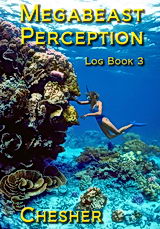To Be Goes Microscopic
If you looked at one of your cells with a powerful microscope you would discover the cell is made up of many smaller individual beings. They are called organelles.
Billions of years ago organelles were free living bacteria. They learned how to work in concert to form communities we recognize as modern cells.
Organelles reproduce themselves by dividing and making duplicate copies of themselves. In fact, all of the tiny creatures in all of the cells (yours, mine, and all living beings) have never died and are over three billion years old.
All visible creatures - with the exception of some colonial bacteria - are associations of the same basic kinds of proto-bacteria. The organelles include centrioles, mitochondria, cilia, nucleoli, chloroplasts and perhaps the nucleus itself.
Each one of these organisms has its own methods of perceiving the environment, gathering essential elements into its focus, refering to its own genetic memory system and information processing network, its own responses, and its own ability to observe the results of its actions. Each bacterium is an individual doing the best it can to survive in its microscopic community.
Bacteria communicate with all the other individual bacteria making up the cell and their collective communication network results in the form and function of the whole cell.
The Basic Pattern
This is how the thread of awareness works.
Small organisms communicate with each other and their communications result in the form and function of a larger organism.
The communications between the bacteria are not the same and don't have the same meaning as the communications between the cells. Just as the cells don't have a clue about the existence of the whole you, or what you are up to, the bacteria don't have a clue about the existence of the cells they create or the trillions of other cells interacting to create you.
These communication webs depend on each other. If the communications between the bacteria stop, the cells stop communicating - and neither you, nor the cells, nor the bacteria, continue to exist.
Organic Molecules
If we look
closely at an individual cell organelle, we discover it is made up of the communication network of millions of living molecules.
Each organic (living) molecule is an individual being, too. It sweeps in information and elements from the atomic world around itself, changes these based on established processes, responds as necessary, and monitors its efforts. The molecules are, in fact, so busy swapping atoms in and out they get hot. Their combined heat would quickly kill us if we did not have an efficient and precise thermoregulation system.
Organic molecules communicate with each other to create the form and functioning of the bacterium.
The communication web of the organic molecules within the bacteria is different from and basic to, the communication web between the bacteria creating the cell and the communication web between the cells creating you.
The largest and most complex of these molecules is called DNA.
DNA records the memory component of the bacterium communication web. Biologists call the memory component of the communication web Genetic Material. Genes are focal points of activity on the long strands of DNA. Genes are essentially stored instructions on how the cellular organelles should respond in certain circumstances. They are activated when "read" by the network of organic molecules creating a bacterium. And the same gene can be read (expressed) in different ways depending on the capabilities and circumstances of the molecules reading it.
The process continues.
A single strand of DNA, a complex living individual, is created by the communication web of billions of atoms.
Each atom is an individual entity; a communication network of sub-atomic particles. And the sub-atomic particles are communication webs of quarks, leptons, strong and weak forces.
The Focus
In summary:
-
Living beings are communication webs of smaller entities.
-
The communication webs (larger beings) guide the future activities of the smaller entities.
-
In this sense, the communication web creates the form and function of the larger and smaller beings at the same time.
-
The communication web of each "level" has its own method of information transmission. The language of each communication is distinct, but some signals penetrate all the levels.
-
Information flows through the communication webs and (this is the tricky part) the flow of information modifies the form and function of the communication web.
-
Individuals, therefore, are focal points in a flow of atoms and energy, and the focusing mechanism is the information flowing through the communication webs.
Now lets follow the thread into a larger domain.



